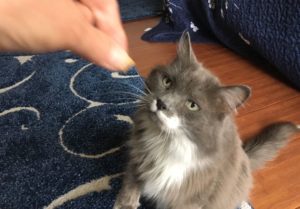Train Your Cat to Sit
Teaching a cat “tricks” or behaviors is much more than just entertainment for us. Having a cat learn to do something on cue allows you to communicate with him. Training can give your cat physical exercise and keep him from becoming bored and restless.
Clicker training pairs a clicking noise (made by a “clicker”, fingers snapping, “mouth click”) with a reward. When your cat responds to a cue to do something and hears the “click”, she looks forward to receiving a treat, head rub or other reward. The behavior is positively reinforced by receiving the reward and your cat is more likely to repeat the behavior when cued.
Why Train Your Cat to Sit?

Let’s say it would be handy for your cat to wait while you fix his dinner or you need him to sit still so that you can look at his teeth or eyes – train your cat to sit!
Getting Started
Choose a time that the cat is calm and up and about. Avoid situations with distractions – have a quiet room where you can have one-on-one time with your cat.
Have treats your cat likes and aim for a time when she is hungry. If she is free fed, you may need to pick up food a few hours before training. If kitty is on a special diet, you may need to train close to meal times and use her regular food to reinforce her.
First, teach your cat that
This will set the stage for further training and communication.
Train your cat to sit by “targeting” and clicker training
- let your cat see and smell the treat
- hold the treat in your hand and raise it slowly up and over kitty’s head
- he will “target” the treat. When he sits, click and give him the treat.
- Repeat 4-5 times a session.
- After kitty has mastered this, add a verbal cue “sit” – say “sit”, and move your hand over his head.
- When kitty starts to sit, click immediately. You can give the reward once he is seated but make sure the CLICK HAPPENS AS HE STARTS TO SIT.
- After several sessions, the cat should sit on cue. Some cats will take longer to learn this than others.
TIP: Start with holding a treat in your hand, then move to having the cat “target” on your hand or finger without the treat.
“Shaping” the “sit”- teaching “stay”
We can use the word, “stay”, and a hand signal, an open hand, to cue a longer sit.
- Say “stay” as you slowly move your open hand toward your cat.
- Click and treat if your cat is still sitting as you count to 3; otherwise lure her back and start over.
- Extend the sit counting to 3-5 seconds. Click and treat if she is still sitting.
work up to a 15 second sit - establish an “OK” cue to mark the end of the sit; you could say “OK” and have the cat target your pointed finger and move away. Be sure to click and treat the “OK”.
- when working with my cats, I use the words “all done” combined with a hand signal where I cross my open hands back and forth several times
For hearing impaired cats – use visual cues
For sight impaired cats – use auditory or olfactory cues
If you are using food, be careful feeding the treat directly from your hand – cats do not see well really close up and may inadvertently nip you trying to get the treat.
Mark the end of all your training sessions with an “all done” signal


1 thought on “Train Your Cat to Sit”